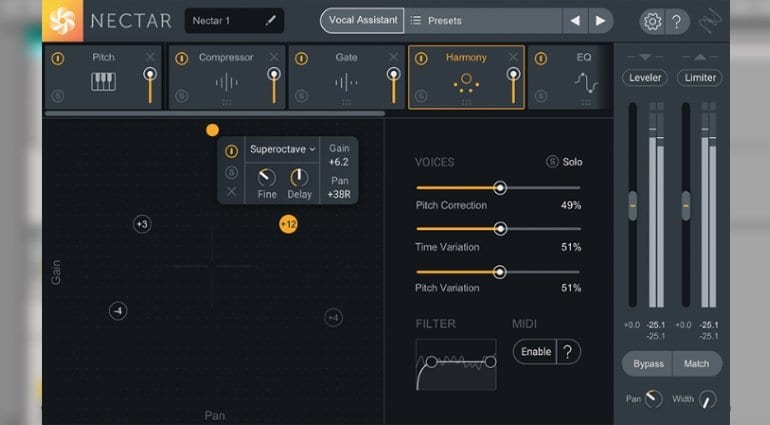


When you’re done analyzing the passage, keep all the sliders save de-ess at 0.0x. Here, I recommend looping a severely sibilated passage first for analysis. Sometimes this is impracticable, as a sibilated passage might throw off analysis for the Dynamic or Tone slider. The inevitable caveat: Nectar Elements needs to analyze audio with sibilants to identify what sibilance sounds like in the vocal performance. The De-ess slider does what it says on the tin: it analyzes where pesky sibilance occurs on the frequency spectrum, and gives you control over how much to reduce the sibilance. Even at 0.5x, it’s going to go after pitch issues aggressively and “synthify” your voice a bit, as evinced by this example: Push the slider to 2.0x, and you’re in robotic Auto-Tune territory-think T-Pain-while a setting of zero disables the Pitch effect. While the Pitch module features adjustable parameters, Nectar Elements is able to determine the vocalist’s range and suggest processing accordingly. The Pitch Slider goes from 0.0 to 2x, and to my ears, it sounds a lot like the Pitch module in Nectar 3.

With this principle in mind, let’s take a closer look at the function and operation of each slider: Pitch slider The slider position would then affect how much attenuation is applied. So what do each of these sliders do? Before getting into that, it’s worth repeating that all of this is based on iZotope’s assistive audio tech: the way each slider affects your audio changes depending on the input signal that Vocal Assistant analyzes.įor example, the function of the Clarity slider will always be the same, but the way it operates will not: if you analyzed a female R&B vocal, Vocal Assistant would tell the Clarity slider to curtail different frequencies than if you had analyzed a male screamo singer. You can start the process over again, raise the output level, bypass everything, and observe the frequency response thanks to a real-time frequency analyzer. All your parameter controls are now visible as easy-to-use sliders: Pitch, Clarity, De-ess, and Dynamics are your “Clean Up” tools, and Tone and Space are offered as “Polish” tools.


 0 kommentar(er)
0 kommentar(er)
